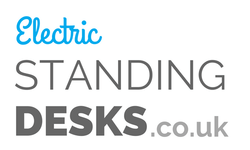So, you managed to convince the boss to get you a standing desk. Congratulations! Here's a link for you to buy a treadmill that'll fit under your desk to see any real health improvements…
Just kidding. You don’t have to pull a Gordon Gekko just yet. However, by spending just a few minutes a day being mobile, while standing at your desk, you can enjoy the endorphins associated with regular exercise and even drastically reduce the risk of heart disease. Here are a few simple exercises you can perform without too much mental commitment.
1. Squats
 The squat is hands down one of the best all round exercises for your body. Historically, we used to sit down and squat everyday, mobilising the hips and knees.
The squat is hands down one of the best all round exercises for your body. Historically, we used to sit down and squat everyday, mobilising the hips and knees.
Nowadays, it’s very rare for an adult to be seen squatting. Even when we bend over to pick up an object, we have a habit of keeping our legs straight. Olympic strength coach Charles Poliquin includes this as a core exercise for all of his clients. It is effective for strengthening the quads, glutes and lower back. You’ll see plenty of benefit for your knees too by strengthening the VMO (vastus medialis origin) muscle, which is responsible for stabilising the joint.
With our modern sedentary lifestyles producing more knee issues than ever, this is one exercise that you simply must do!
How to Squat Safely
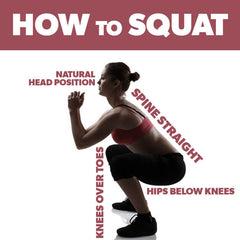
- Keep your back straight for the entire motion and your neck in a neutral position.
- Try to keep your weight over the mid-foot and don’t raise your heels off the floor. A good way to do this is to almost lift your toes off the floor. This ensures that your lower back is not stressed unsafely.
- Start with 3 sets of 10 each day unless you can manage more, building up to 3-4 sets of 25 to make sure you get the most out of them for your health.
- If this is too challenging, don’t worry! Just hold onto a desk or chair for support and work your way up to squatting unassisted.
- If ordinary squats are too easy, try experimenting with one legged pistol squats. This great guide by Gold Medal Bodies shows how you how can work up to this. By the way, if you can do these, you are awesome!
Within 2-3 months, you should start feeling an all round sense of stability in your joints. You’ll also be rewarded with a renewed sense of "bounce", which many of us haven’t felt in years!Stand with your feet shoulder width apart and lower your buttocks down to the floor as far as they will go.
2. Calf Raises
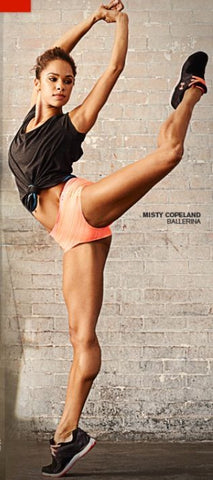 The ballet dancers’ secret for amazing looking calves is that they are constantly on their toes. A tiny ballerina might not be your instant "go-to" answer, if you were asked who has awesome strength-to-weight ratio in their lower legs - but you try spending hours one toe!
The ballet dancers’ secret for amazing looking calves is that they are constantly on their toes. A tiny ballerina might not be your instant "go-to" answer, if you were asked who has awesome strength-to-weight ratio in their lower legs - but you try spending hours one toe!
Professional ballet dancers train their calves daily, sometimes for hours a day, by performing body-weight calf raises. Eventually it turns into an effortless movement - and therein lies the answer. The calves are a resistant muscle group to train and professional body builders will tell you that you need to train them daily. In fact, Arnold Schwarzenegger massively advanced his bodybuilding career with daily calf training. And ladies, if you’re afraid of acquiring monstrous calves, don’t be. The slender physiques of the ballet dancers are complemented with amazing calf muscles.
Furthermore, if you’ve been plagued with sprained ankles over the years, then calf training is probably the answer. Strengthening the calves is a sort of "prehabilitation" for your ankles. If you’re engaged in recreational activities such as tennis, squash or even running, you will definitely see value in this routine.
Neglect them at your peril!
How To Perform Calf Raises Correctly
- Stand barefoot with your legs shoulder width apart and your toes slightly pointing outwards. This is important. Being barefoot allows you to train the tiny muscles responsible for stabilising the foot and will improve your proprioception. More on this later.
- Over a count of 2 seconds, slowly raise your heels off the floor being sure to keep your body super-straight – almost as if you have a piece of string pulling from the top of your spine. Make sure that you don’t bend forwards.
- Contract hard at the top for a count of 2 seconds.
- Lower your heels slowly to the floor for a count of 2 seconds.
- Repeat until you’ve performed 50 reps. This is much harder than it sounds!
- Work up to 100 reps. This takes only 10 minutes a day.
- If you do this everyday for a month, you will see noticeable results when you stand in front of the mirror.
3. Warrior Pose
There is one muscle in your body that has been shown to be a reliable indicator of strength and overall body health. In fact, it’s been called the body’s most powerful hidden survival muscle. When it’s too tight, or in a weakened state, it can contribute to issues such as:
- Lack of explosiveness in training
- Digestive problems
- Loss of sexual performance
- Trouble sleeping
- Overall bad posture
- Weak immune system
Can you guess what it is?
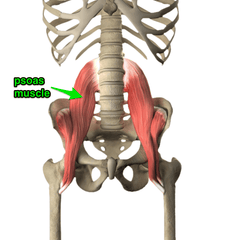
The psoas major muscle is the ONLY major muscle in your body that connects the upper body to the lower body. Kudos, if you got that right. It is essentially a hip flexor that is responsible for your ability to sit, stand, twist, reach, even walk. Tight hip flexors affect not only your body, but your whole well-being. No matter how hard you train and how well you eat, if you are affected by any of the conditions above, then you need to pay attention to this!
Your hips are so important. Simply put, the psoas major is the core of activity within your body and when functioning correctly, it has the power to:
- Rapidly drop body fat
- Flood your mind and body with energy
- Hit your peak of sexual health
The number one activity that we perform everyday, that’s making you fatter, weaker and killing your sex life is… SITTING! Even if you’re an active individual, you are probably suffering from a tight psoas from spending years sitting in a chair all day. It’s great that you got a standing desk, but standing still isn’t the complete answer. You will need to actively stretch the psoas to unlock your peak health.
Here is a short routine to perform every day. Yes, every day. Any physio will tell you that a couple of minutes here and there will get you almost no benefit. In fact, it’s commonly understood by mobility experts that by doing 5-10 minutes of stretching every day, you will begin to see noticeable improvements in your flexibility after only 6 weeks! Consistency over a long period is essential to experience the benefits of any stretching regimen.
How To Release Tension In The Psoas Major

- Stand square with legs shoulder-width apart and lunge forwards, as shown photo.- this is a classic yoga pose
- Next bring your arms up palms facing each other and stretch upwards, while gently leaning back
- You should feel a gentle pull in your inner abdomen and hips.
- Hold this position for 15 seconds
- Repeat on each leg until you’ve performed 5 reps on each leg
- Do this twice a day. You will begin to see an improvement in your hip mobility within 6 weeks
If you are interested releasing your psoas even further, here is a useful guide by Yoga International.
4. Single Leg Balancing
The cult classic "Born To Run", which is a fantastic book recommended by productivity hacker Tim Ferriss, makes a big deal of how proprioception in the feet is essential for healthy running. Proprioception is the sense of your body’s position and orientation. The tiny receptors in our feet provide sensory feedback to your brain to coordinate the minute adjustments in posture that allow us to maintain balance. Decades of running and walking in thickly padded soles have rendered these receptors dumb, negatively affecting posture whilst running and drastically increasing the chance of injury.
This goes hand in hand with the barefoot calf raises. Training proprioception in your feet will go a long way to injury-proofing your body.
How To Train Single Leg Balance
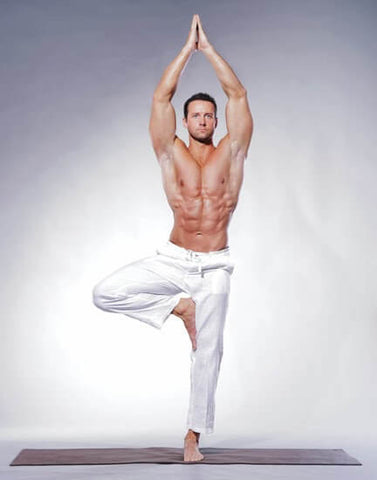
- Stand barefoot and balance on one leg, resting your raised foot on your calf. Try to keep your knee pointing outwards as far as possible.
- Keeping the rest of your body straight and still, put your hands above your head, like in the picture. If this is too tricky, press your hands together in front of your chest with your fingers pointing upwards. Imagine a piece of string gently pulling from the top of your spine to help straighten your body.
- Close your eyes for an added challenge!
- Hold this position for 10 seconds and repeat 10 times on each foot
- When this gets easy, get yourself a wobble board. This is a fantastic tool for building excellent proprioception in the feet and overall balance. You will probably need to hold on to your standing desk at first.
Follow this routine daily for 6 weeks and you will have awesome injury-proof feet.
5. The "Stomach Vacuum"
You may have heard that doing countless ab crunches and sit-ups will strengthen the abs and go some way towards a six pack, but it will do little to give you a smaller waist.
Most people don’t know that there is a hidden muscle called the transverse abdominis that sits behind your rectus abdominis or "six pack". Body builders train this to get a smaller waist. In fact, the following exercise was one of Arnold Schwarzenegger’s signature exercises for his famous pose. Even Tim Ferriss has a kneeling variation in his bestseller "The 4-Hour Body" - another fantastic compendium of hacks for rapid physical development and injury rehabilitation.
How To Correctly Perform The "Stomach Vacuum"
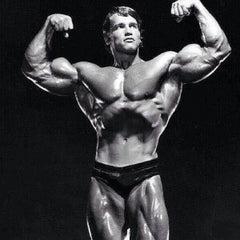
- Stand upright with hands on hips, then exhale ALL of the air out of your chest.
- Next expand your chest without breathing back in any air and bring your stomach in as much as possible. Then hold. You want to visualise your belly button coming in touch your spine.
- Hold for 20 seconds and repeat for 3 reps, resting 1 minute between each rep.
- Do this daily, slowly building up to 60 seconds per rep over a set of 6 reps.
You will begin to see an reduction in your waist size. Your belly will have a tighter appearance. This is a seriously under-rated exercise. You want to do this, trust me.
Following all of these exercises at your standing desk for several weeks will transform the way you feel and the way you look. Long term consistency, however, is key. Don’t focus on seeing gains every day. Just be disciplined enough to show up and do your work then go home. All of these exercises can easily fit around your work day, in lunch and coffee breaks. They are also a great way to punctuate your work with quick 10 minute recharges.
If you haven’t already got a standing desk, then you want to look into getting one here. They are such an amazing tool with hosts of hidden health benefits. Remember, sitting is the new smoking!
We hope you enjoyed reading this article. If you liked what you read, please do us a favour share on it Facebook, Twitter or Google+ using the links below.
